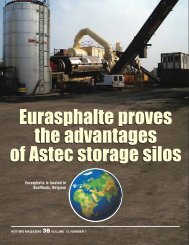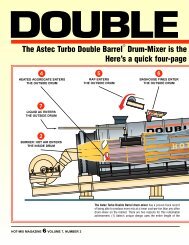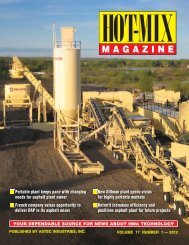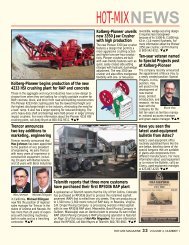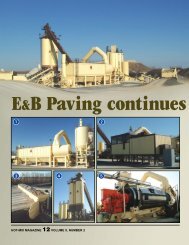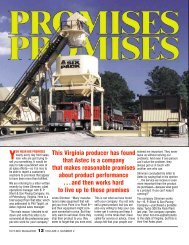P & S Paving Case Study - Be frap Ready
P & S Paving Case Study - Be frap Ready
P & S Paving Case Study - Be frap Ready
You also want an ePaper? Increase the reach of your titles
YUMPU automatically turns print PDFs into web optimized ePapers that Google loves.
state-of-the-art<br />
RAP PROCESSING<br />
The RAP-fractionating or processing activity at P & S <strong>Paving</strong> begins with a<br />
front-end loader depositing RAP—the by-product of the company’s roadmilling<br />
operations—into the 42-in. x 16-ft. (1.0 x 4.9-m) Telsmith vibrating<br />
grizzly feeder (left photo, above). The material then passes to the Telsmith 5252<br />
HSI horizontal shaft impactor (right photo, above) where it is crushed to the<br />
predetermined size. If ever a very large chunk hangs in the inlet, a guillotine<br />
powered by two cylinders will cut and force the chunck into the crusher,<br />
eliminating extensive shutdowns.<br />
HOT-MIX MAGAZINE 26 VOLUME 9, NUMBER 2
WHEN YOU GET A GOOD IDEA<br />
from someone you respect,<br />
the next logical step is to<br />
follow through and put that idea<br />
into practice. About two years<br />
ago, Tim Phillips—president of<br />
P & S <strong>Paving</strong>, Inc. in Daytona<br />
<strong>Be</strong>ach, Florida—attended an<br />
Executive Seminar at the Astec<br />
headquarters in Chattanooga,<br />
Tennessee. One topic discussed<br />
in that seminar resonated for<br />
Phillips: Fractionating RAP.<br />
“I was so impressed with that<br />
part of the seminar that I called<br />
back here to the plant before the<br />
first day was even over,” Phillips<br />
said in a Hot-Mix Magazine story<br />
in 2001 (Volume 6, Number 1).<br />
“And I told them to start doing it<br />
immediately. Some of the people<br />
at the seminar were just sitting<br />
there, shaking their heads, like it<br />
wouldn’t make much difference.<br />
Well, I’m here to tell you that we’re<br />
running higher percentages of<br />
RAP now—and the quality of the<br />
asphalt is far superior to what it<br />
was under our old procedure.”<br />
Fast-forward three years. Now<br />
you will find that P & S <strong>Paving</strong> is<br />
having continued success with<br />
fractionating RAP, but they have<br />
added a new twist: a completely<br />
self-operating, closed-loop RAPprocessing<br />
facility. And this cutting-edge<br />
technology has helped<br />
propel P & S <strong>Paving</strong> to the top of<br />
their market.<br />
Fractionating RAP<br />
is the act of processing it<br />
to screen, crush, size, and separate<br />
the various sizes<br />
into stockpiles that are<br />
uniform in size and composition.<br />
“Today we’re running 50 percent<br />
RAP, whenever state specifications<br />
allow,” said Phillips in a recent<br />
interview. “And we’ve perfected it.<br />
In the old days, we were out<br />
there, like most other contractors,<br />
taking up asphalt on jobs that we<br />
had paved because we got out of<br />
specification. Today, since we<br />
added this machine, we haven’t<br />
taken up a single ton of asphalt.”<br />
A new stage in<br />
fractionating RAP<br />
For most people, fractionating or<br />
processing RAP is not an entirely<br />
new concept: by sizing RAP and<br />
separating it into specific piles, a<br />
producer gains more control<br />
over the size and amount of the<br />
reclaimed aggregate that goes<br />
into new mixes, as well as the<br />
amount of liquid-AC that is being<br />
used during production.<br />
This is the concept that captured<br />
Phillips’ attention at the Astec<br />
Executive Seminar back in 2001.<br />
But early in 2004, Phillips and<br />
Astec Industries CEO Don Brock<br />
began talking together about a<br />
slightly different concept: a RAPprocessing<br />
facility that would<br />
crush, size, separate, and store<br />
RAP—all within one automated,<br />
closed-loop system.<br />
“We wanted to make sure that it<br />
did not have an operator,” said<br />
Phillips. “We wanted to merely<br />
turn it on, and then the only<br />
manpower needed would be the<br />
loader operator.”<br />
Once material enters this system,<br />
oversized material is screened<br />
and then fed back to the crusher<br />
until it is sized correctly and can<br />
be deposited into one of two piles:<br />
1/4-in. (0.635-cm) minus and 1/4-<br />
to-1/2-in. (0.635-to-1.27-cm).<br />
Phillips avoids using the word<br />
crushing. “Even though the oversized<br />
material is passed through<br />
a crusher,” he said, “we don’t<br />
like to call it crushing. Instead, we<br />
like to think of it as separating.<br />
We are actually separating the<br />
millings and returning them back<br />
to their virgin state. We don’t<br />
want a true crushing operation<br />
because crushing creates fines—<br />
and fines create problems.”<br />
Phillips said that once the RAP is<br />
separated, the material is handled<br />
just like any virgin aggregate. “The<br />
only difference is that this material<br />
is coated black. And that one<br />
fact makes the material extremely<br />
valuable to us.”<br />
At their location in Florida, P & S<br />
<strong>Paving</strong> has limited resources for<br />
virgin aggregate: it is shipped by<br />
rail from either Georgia or south<br />
Florida. This, of course, drives up<br />
the cost of the aggregate to about<br />
$20 per ton. Plus, Phillips pointed<br />
out, the costs of liquid-AC<br />
has continued to rise.<br />
Meanwhile, P & S <strong>Paving</strong> seems<br />
to have an endless supply of RAP<br />
from their milling operations.<br />
“<strong>Be</strong>fore this RAP-processing<br />
system came in, our milling piles<br />
were becoming enormous,” said<br />
Phillips. “We were looking for more<br />
land where we could put all the<br />
millings we were accumulating.<br />
We realized that we needed to do<br />
something—we actually needed<br />
to be using the same amount of<br />
millings that we were bringing in.<br />
“Now, we’ve solved that problem.<br />
Since we installed this system,<br />
our RAP piles have remained at a<br />
constant size rather than growing.<br />
After leaving the Telsmith HSI crusher, the material moves to the PEP PSP<br />
2618M screening plant (left photo, above). This unit has a double-deck high-frequency<br />
screen with a 6 x 18-ft. (1.8 x 5.5-m) top deck and a 6 x 12-ft. (1.8 x<br />
3.7-m) bottom deck. The material is separated into two sizes, with oversize<br />
returning to the crusher. The screened material moves on belts to a system of<br />
radial-stacking conveyors (right photo), each of which has a 30-in. x 70-ft. (76-<br />
cm x 24-m) stacking conveyor. The sized RAP is then deposited into stockpiles.<br />
In a single day, P&S <strong>Paving</strong> processes about 1,000 tons (900 tonnes) of RAP.<br />
HOT-MIX MAGAZINE 27 VOLUME 9, NUMBER 2
That’s because of the increase in<br />
the percentage of RAP that we’re<br />
able to use in new mixes: Instead<br />
of running 30 percent RAP, we’re<br />
now running 50 percent.”<br />
Unique equipment<br />
equals serious production<br />
P & S <strong>Paving</strong> knows how to use<br />
state-of-the-art equipment to<br />
promote company growth—and<br />
to turn out serious production<br />
rates. Several years ago, they<br />
upgraded from a 1956 batch plant<br />
to a brand new Astec Turbo 400<br />
Double Barrel ® drum-mix plant.<br />
With three paving crews out in<br />
the field, that HMA plant is now<br />
producing close to 450,000 tons<br />
(408,000 tonnes) per year.<br />
“We’re literally running it around<br />
the clock, almost 24 hours a day,<br />
seven days a week,” Phillips said.<br />
“We’re getting very good volume<br />
out of one plant!”<br />
With that high production rate,<br />
the new RAP-processing plant<br />
needed to be able to keep pace.<br />
One element that keeps the processing<br />
plant moving is the fact<br />
that not all of the RAP has to go<br />
through the crusher.<br />
“<strong>Be</strong>fore we got this system, we<br />
merely threw RAP onto a highfrequency<br />
screen—and 70 percent<br />
of the return was material<br />
that didn’t really need to be<br />
crushed,” said Phillips. “With the<br />
new RAP-processing plant, we<br />
have the ability to go around the<br />
crusher. We simply throw the<br />
RAP into a hopper, screen it, and<br />
separate it by size. Everything<br />
that is oversized automatically<br />
goes to the crusher. If everything<br />
went straight into the crusher,<br />
we would end up crushing all of<br />
the material and creating more<br />
fines. This system avoids that<br />
problem completely.”<br />
Phillips said that P & S <strong>Paving</strong><br />
will have used more than 200,000<br />
tons (181,500 tonnes) of RAP by<br />
the end of 2004. In order to do<br />
that, the plant’s Telsmith 5252<br />
HSI horizontal-shaft impact<br />
crusher processes about 350 tph<br />
(317 tonnes per hour). “We crush<br />
about 1,000 tons (900 tonnes) a<br />
day,” said Phillips. “It is extremely<br />
fast: It only takes about four hours<br />
to crush that amount.”<br />
P & S <strong>Paving</strong> used<br />
more than 200,000 tons<br />
of processed/fractionated RAP<br />
in the first six months<br />
that the system was in operation.<br />
Whenever specs would allow,<br />
they were running 50 percent RAP<br />
in their new mixes.<br />
P & S <strong>Paving</strong> upgraded to state-of-the-art hot-mix-asphalt technology in 2001<br />
with the purchase of the Astec Turbo 400 Double Barrel ® drum-mixer plant shown<br />
here. The installation included the drum-mixer, a five-compartment cold-feed<br />
system, and a one-compartment RAP feed system. A single 200-ton (181-<br />
tonne) Astec storage silo was part of the original order, but a second silo was<br />
added later. According to Tim Phillips, president of P & S <strong>Paving</strong>, the new plant<br />
has allowed the company to expand its hot-mix production and paving operations<br />
significantly. With the addition of the RAP-processing system earlier this year,<br />
the company has no problem running new mixes with 50-percent RAP content.<br />
FOR MORE INFORMATION<br />
about RAP-processing, contact one of these resources:<br />
Diane Hunt at Astec, Inc.<br />
Phone: 423-867-4210 • Fax: 000-000-0000<br />
E-mail: dhunt@astecinc.com<br />
———<br />
Jim Schreiner at Telsmith<br />
Phone: 800-765-6601 • Fax: 262-242-6600<br />
E-mail: jschreiner@telsmith.com<br />
———<br />
Ron Earl at Astec Mobile Screens<br />
Phone: 800-545-2145 • Fax: 815-626-6430<br />
E-mail: sales@astecmobilescreens.com<br />
In order to assure the best-quality<br />
material, P & S <strong>Paving</strong> creates RAP<br />
inventory on a just-in-time basis.<br />
In other words, they process<br />
only as much RAP as they will<br />
need and when they will need it.<br />
“We do that for an important<br />
reason,” explained Phillips. “The<br />
processed-RAP piles will actually<br />
harden if they sit there with the<br />
sun beating down on them. So we<br />
process the RAP on a day-by-day<br />
basis—typically the day before<br />
the material is to be used in the<br />
hot-mix plant. There is another<br />
advantage to that: We do not let<br />
the piles get wet—and that cuts<br />
down on drying costs.”<br />
One more safety measure that<br />
P & S <strong>Paving</strong> has put in place is<br />
their quality-control program.<br />
“We have set up a quality-control<br />
plan in order to do daily checks on<br />
the volumetrics of the RAP, as well<br />
as the viscosity,” said Phillips.<br />
“That report is turned over to the<br />
Florida DOT.”<br />
Phillips said that despite the daily<br />
checks by their technicians, P & S<br />
<strong>Paving</strong> has found that the volumetrics<br />
and viscosity tend to be<br />
very consistent. This is due in<br />
part to the care and attention to<br />
detail that is taken by the operator<br />
of the front-end loader.<br />
“The loader operator can see<br />
color changes in the RAP piles.<br />
If the pile starts getting streaky,<br />
then he knows the AC content is<br />
not consistent,” said Phillips.<br />
“So, the operator can help you or<br />
hurt you in that process—and we<br />
have trained our loader operators<br />
to feed that crusher consistently.”<br />
Since the RAP-processing facility<br />
went into operation about six<br />
months ago, Phillips said it has<br />
attracted the attention of others<br />
in the industry. “We’ve had some<br />
of our competitors come in and<br />
look at it—and I think one of them<br />
even purchased a system like it,”<br />
he said. “We’re not doing anything<br />
magical here. Producers<br />
have been crushing RAP for a<br />
long time. But they have not been<br />
screening it on a high-frequency<br />
screen like we do here.<br />
“That’s the real difference in what<br />
we’re doing.” ▼▲▼<br />
HOT-MIX MAGAZINE 28 VOLUME 9, NUMBER 2



